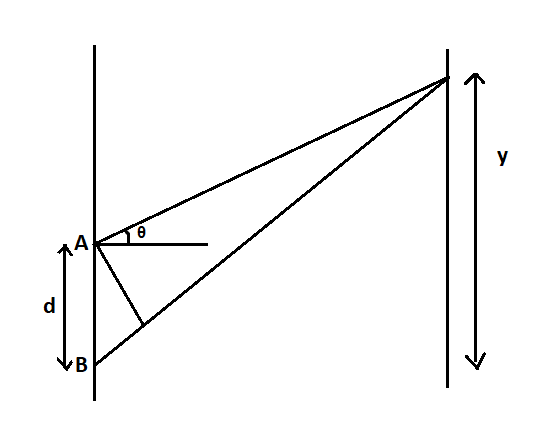Question
Question: Derive the formula \( \omega = \dfrac{{D\lambda }}{d} \) for fringe width in Young's double-slit exp...
Derive the formula ω=dDλ for fringe width in Young's double-slit experiment. The symbols used have their usual meanings.
Solution
Hint
In Young's double-slit experiment, we have two slits separated by a distance. Two coherent sources will produce an interference pattern. This will create alternate bright and dark fringes. The separation between the two consecutive bright fringes is called the fringe width.
Complete step by step answer

As shown in the figure, there will be two rays of light from the two slits A and B. The rays will have a path difference. The path difference can be written as,
⇒dsinθ=nλ ………………………………………………..equation
Where θ is the angle between the incident ray and the normal. d is the distance between the slits, n is an integer that stands for the order of the fringes, and λ is the wavelength of the light.
We know that, for small angles sinθ≈θ
Then we can write equation as,
⇒dθ=nλ
From this we get θ=dnλ
Let the screen be placed at a distance D and let y be the position of maxima
⇒Dy=tanθ
For small angle tanθ≈θ
Hence we can write the above equation as
⇒θ=Dy
From this equation we get,
⇒y=Dθ
Substituting the expression for θ from equation, we get,
⇒y=dnλD
The fringe width can be written as the difference between two maxima,
For an nth order fringe, Yn=dnλD
And the (n+1)th order fringe, Yn+1=d(n+1)λD
Let ω be the separation between two consecutive bright or dark fringe then
The fringe width can be written as,
⇒ω=d(n+1)λD−dnλD
⇒dλD(n+1−n)
Therefore we get,
⇒ω=dDλ
Note
The width of the fringes is inversely proportional to the separation between the slits, i.e. when the separation between the slits (d) increases, the fringe width will decrease. The separation between the slits and the screen is directly proportional to the fringe width i.e. when the separation between the slits and the screen (D) increases the fringe width increases.
